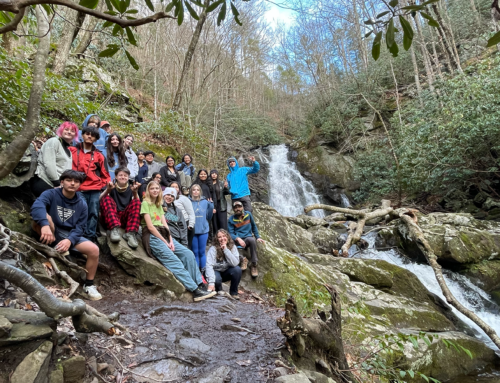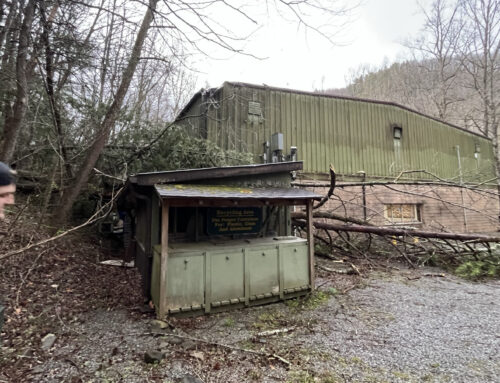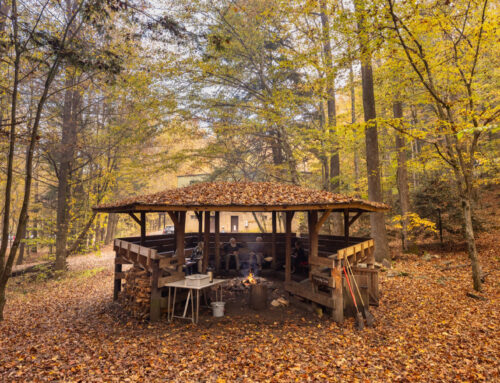Every year, we monitor our breeding birds in Walker Valley by setting up a series of 12 m long soft mesh mist nets on our campus once or twice a week. We check the nets every 40 minutes, remove any birds that get caught, bring them back to our banding station for processing, and release them unharmed to go about their business. Getting caught in a mist net does not hurt the birds, and our citizen science team is trained with special techniques for safely extracting them.
We take several measurements of each bird including wing length, mass, fat content, extent of body and flight feather molt, flight feather wear, feather age, etc. We use these characteristics to give us clues to the bird’s overall health and age. It’s like fitting together the pieces of a puzzle!

Since we have been banding songbirds in Walker Valley since 2002, we have accumulated a long-term dataset that helps us to understand the number and distribution of species that breed here, the age structure, habitat structure and change, and other factors.
Recapturing individuals from year to year is exciting because it tells us not only how long the bird lives, but it also helps us to understand more about habitat selection and recruitment of young birds into the adult population. For example, if we band a juvenile bird in its first summer and catch it as a breeding adult the following summer, we know that it was successfully recruited into the adult population. This is good news for a healthy reproducing population.
A few notable recaptures:
- On our first day of banding, we recaptured a Louisiana Waterthrush named Dovenbarger who was banded as a Hatch Year in 2017. This is exciting because it’s evidence of successful recruitment of a young bird into the adult breeding population. Dovenbarger would have migrated to the Caribbean or Central America last winter and then made her way back to the same valley where she was raised. We found out that she’s a female (because you can’t confirm gender on juvenile waterthrushes) because she had a brood patch used for thermoregulating chicks. We also honored her with a full color band combination (three colors plus one aluminum band) because Hatch Year birds only receive one color band.
- We caught Obi Wan the Louisiana Waterthrush twice on our first banding day. He was banded as a Second Year bird in 2017, so we know that he is exactly three years old. He is the reigning king of Walker Valley, defending a territory that stretches from Loan Branch near the cemetery to the Middle Prong River near the Lagoons. This territory has been passed down from another dominant male, our old friend Mr. Dorsey the waterthrush.
- On June 12th and 19th, we caught Nola, a Third Year male Louisiana Waterthrush who was banded as a nestling in 2015 and named Nola because we didn’t know at the time that he was a boy. His territory encompasses the upper part of campus, including Girl Scout Island and the Friendship Circle.
- On July 5th, we caught an After Third Year Black-and-white Warbler that was banded as an After Second Year bird in 2016. This means that she is at least 4 years old, and perhaps older. Interestingly, she was caught across the river in 2016 and by the blacktop on campus this year.
- On July 25th, we caught our only Northern Cardinal for the season, an After Second Year female who was banded in 2016. She was caught in almost exactly the same place as she was two years ago, which indicates her site fidelity.

This graph shows the number of each species of bird we caught during the summer of 2018, compared to the number of recaptures of each species. We caught and recaptured more Louisiana Waterthrushes than any other species, which is what makes us so well-positioned to study them as part of ongoing research. Check out Lee Bryant’s research.
My favorite capture for the season was a juvenile Sharp-shinned Hawk that completely took us by surprise on one of our very last banding days. Our nets are designed for smaller birds, so anything bigger than a Robin usually bounces right out. The hawk drew a sizable crowd of awe-struck humans as we gingerly banded and measured it. Its bright yellow eyes were piercing and beautiful. We were humbled to hold such a majestic creature.

Another of our favorite moments was when a female American Goldfinch didn’t fly off immediately once she was released. She hung out on a branch just outside the Council House, looking down at us. As soon as we released the next bird we processed, a male American Goldfinch who was caught at the same time, she chipped and then flew off with him. It seems she waited for us to release her mate from bondage!
We have many stories like this from our adventures in bird banding. Our banding station is open to the public and we enjoy teaching people of all ages how to safely hold and release wild birds.
Bird banding by the numbers:
Total captures: 65
Total recaptures: 23
Total species: 15
Total number of people that visited the banding station: 197
Come out next year to enjoy an up-close encounter with our feathered friends! Our 2019 banding dates should be posted by May.
For the birds,
Tiffany Beachy
Manager of Science Literacy and Research







